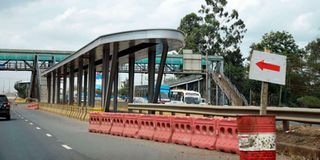Breaking News: Old Kijabe dam tragedy: Death toll rises to 45
State in plan to spend Sh1.14bn on Nairobi BRT

A Bus Rapid Transport (BRT) station under construction along the Thika Superhighway in this picture taken on August 17, 2021. The State has allocated Sh1.14 billion to finance the implementation of the BRT project in the financial year starting July.
The State has allocated Sh1.14 billion to finance the implementation of the Nairobi bus rapid transport (BRT) project in the financial year starting July.
The national government will provide Sh1 billion while the balance will be footed through foreign financing, the National Treasury said in its expenditure plan for the new fiscal year.
This will mark the second consecutive budget cycle where the project has been allocated substantial amounts. In the current financial year, the BRT project was allocated Sh1.17 billion, a significant increase from the previous financial year’s Sh700 million.
The BRT project seeks to help decongest traffic within Nairobi and its environs. It will have dedicated lanes and is being constructed by Stecol Corporation, previously known as SinoHydro Tianjin Engineering Company.
The Nairobi Metropolitan Area Authority has gazetted 12 mobility corridors for the BRT, seven of them for core mass rapid transportation linking Limuru, Ngong town, Kenol, Murang’a, Kiambu, Ruai, Jomo Kenyatta International Airport (JKIA) and Konza techno city.
Line 1 is to run from James Gichuru Road/Waiyaki Way to JKIA, a distance of 20 kilometres, while Line 2, which is 31 kilometres long, will run from Lang’ata Road to Ngong Road as well as Juja Road and Komarock Road to Ruiru. It will have major stops at Dandora, Kariobangi and near Gikomba market.
Line 3 will run from Githurai through Thika Road to Moi Avenue in the CBD and terminate at Kenyatta National Hospital. Line 4 will cover 14 kilometres from T-Mall to Jogoo Road while Line 5 will cover Outer Ring Road.
Priority corridors
Priority corridors are the JKIA to Likoni, James Gichuru-Rironi, and Bomas to Ruiru roads.
The 27-kilometre Kasarani-Kenyatta National Hospital line is expected to be among the first to become operational and is part of the second corridor that runs from Kenol to Rongai.
A park-and-ride facility is being set up at Kasarani, where motorists heading to the city centre can leave their vehicles and use BRT for the remainder of the journey.
The Transport Ministry said last year that high-capacity electric buses would be deployed on the BRT to reduce the cost of public transport as they will be cheaper to operate, attract better financing and reduce the country’s carbon footprint.
Work on the designated BRT stations has stalled at Garden City, Safari Park, Roysambu, Clayworks, Kahawa Barracks, and Kenyatta University, with no activity going on for months.
Apart from using BRT to tackle congestion in Nairobi, the State also plans to introduce a traffic congestion charge for motorists—a fee charged on cars driven in zones marked as heavy traffic areas such as the CBD.
A draft policy document published by the Treasury in February revealed the plans.
Kenya will follow in the footsteps of major cities that have introduced or are on course to unveil the traffic congestion charge.
“The government will explore the development of a congestion charging scheme in the cities, as a source of revenue for greening the sector,” states the National Green Fiscal Incentives Policy Framework.





